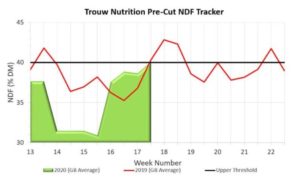Grass growth has continued to increase, up 4kg DM/ha/day on last weeks figures to 51kg DM/ha/day due to the continuation of the warmer spring weather. The East and Yorkshire saw the lowest grass growth figure of 45kg DM/ha/day and 40 kg DM/ha/day, respectively. The West Midlands and South West saw growth rates of 54kg DM/ha/day.
The average potential MYFG has seen a drop of M+2.9 litres per day versus last week and averages at M+7.1 litres. Although a decrease has been seen, this figure is much closer to the 6-year average of M+ 7.3 litres per day and exceeds last years: M+6.6 litres per day. This decrease in potential MYFG can be a result of decreased potential DMI, meaning that higher intakes would be required to achieve target nutrient intakes. The variation across regions is not as wide as last week; the East reaching M+8.2 litres per day and Scotland, with the lowest figures, at M+1.2 litres per day. Trouw Nutrition received samples from all regions this week.
However, 66% of MYFG samples were received from Wales and West, while the North East combined with Yorkshire accounted for 2% of samples and Scotland for 4% of samples. Please keep in mind that while Wales and West may see improved accuracy due to the large data set. It is difficult to draw conclusions from areas where limited samples are received.
For the forthcoming week (WC 27th), warmer weather and spring showers are forecasted, and increased grass growth is expected. This is a high-risk time for grass staggers, a result of low magnesium and high potassium content in the grass. Therefore, it is important that Mg requirements are met to limit deficiencies and incidences of associated risks.
*Trouw Nutrition is hosting a Magnesium Webinar on the 1st May, 1-2pm, please click this link if this is something of interest: https://bit.ly/3aIWLoX
Compared to last weeks figures, grass ME has decreased, average at 12.57 MJ/kg DM. Sugar levels are also low at 10% and when combined with this week’s crude protein level of 23%, the ratio of sugar to CP is not near the recommended 2:1 for optimum nitrogen use efficiency in the rumen. Reducing protein levels in compound feeds can be a control strategy to mitigate the risk this can have on health and performance.

Latest Pre- Cut tracker
This week, pre-cut samples have increased, with an average NDF content of 40.09%. This suggests that many crops are ready for cutting, and whilst it may seem early for many farms, achieving a cut now will allow for re-growth before we hit peak grass growths.
If farms do cut for silage now, ensure the forage is wilted to an optimum dry matter of 32 – 35% to avoid a wet leafy 1st cut, which can be difficult for cows to fully utilise.

